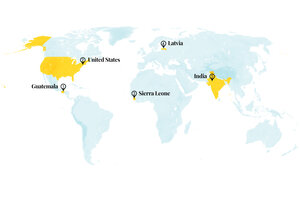Gaming as serious work for students, and trees that celebrate girls

1. Guatemala
Geologists detected a sprawling Mayan site hidden underneath the Guatemalan rainforest. Aerial lasers can penetrate thick tree canopy, in this case revealing nearly 1,000 settlements dotting the Mirador-Calakmul Karst Basin, a region that spans northern Guatemala and southern Mexico, and the surrounding ridge.
The scans show evidence of ancient cities, towns, and villages home to pyramids, canals, and reservoirs and connected by some 177 kilometers (110 miles) of elevated causeways. The remains are predicted to date back to the pre-classic period between 1000 B.C. and 150 A.D.
According to Ross Ensley, co-author of the study published in the journal Ancient Mesoamerica, the region is considered to have been a “Goldilocks Zone” for the Maya. Uplands were rich in limestone for building, and the seasonal swamps of the lowlands provided nutrient-rich soil for agriculture. The images revealed “for the first time an area that was integrated politically and economically, and never seen before in other places in the Western Hemisphere,” said co-author Carlos Morales-Aguilar.
Sources: Live Science, Ancient Mesoamerica
Why We Wrote This
Our progress roundup highlights the potential of young people. In Latvia, the popular Minecraft game is empowering kids to think about civic improvements. And in India, trees planted to celebrate newborn girls have greened a mining town.
2. United States
The New York Harbor has largely recovered from ecological collapse. The catch basin of the Hudson River was treated as something of an open sewer as recently as the 1970s. Over 200 million gallons of raw sewage used to flow daily into the river, where it combined with industrial contaminants and trash. In 1972, a bipartisan Congress overrode a presidential veto to pass the Clean Water Act. Today, the basin’s ecology has been mostly restored thanks to the act’s strict regulations on outflow from sewage plants and factories.
Health advisories still warn against eating Hudson River fish. But signs of recovery unthinkable half a century ago are now common. People take part in swimming events in the harbor. Herons, bald eagles, and sturgeons are making a comeback, and oyster reefs are rallying. A dozen humpback whales were spotted in the river last fall, and dolphins were sighted in the nearby Bronx River last month.
Source: The New York Times
3. Sierra Leone
Sierra Leone is experiencing a watershed moment for gender equality legislation. The new Gender Equality and Women’s Empowerment Act stipulates that public and private employers must employ a minimum of 30% women in decision-making positions, and that 30% of candidates on political party slates for parliamentary and local offices must be women. Employers owe women equal pay, training, and educational opportunities, and there are fines for discrimination.
The act goes into effect alongside the Customary Land Rights Act, which ensures that women’s right to own land is respected. Most land in the country is governed by customary law, requiring that either the oldest male of a family or the village chief control the land. Under the legislation, citizens “shall not be refused the right to hold, use or acquire land that is subject to customary law” based on gender, tribe, religion, ethnicity, age, marital status, social status, or economic status. In a country that was ranked 181st out of 191 on the United Nations’ Gender Development Index in 2020, both laws respond to years of advocacy by women’s organizations at home and abroad.
Sources: Quartz, The BBC
4. Latvia
Students in Riga, Latvia, are using a virtual model of the city on Minecraft to learn about urban planning. The video game, played by some 100 million people around the world, lets users design, explore, and build 3D spaces. The educational edition of the game has become part of the curriculum at the Bolderāja Music and Art School in a suburb of Riga, allowing students to think creatively about their city.
The United Nations began using Minecraft to encourage youth civic engagement in 2012, expanding to projects in 37 countries. Known as Block by Block, the program is often the first time participants are given a platform to express their opinions about public issues.
Sources: Riga City Council, United Nations, Danish Cultural Institute
5. India
An Indian village in Rajasthan has planted 400,000 trees to honor both young women and nature. Shyam Sundar Paliwal planted his first tree after the death of his 17-year-old daughter in 2007. From there, he and other villagers from Piplantri began planting 111 trees for every newborn girl. Families pledge to educate their girls and ensure they marry only after turning 18. The community in turn gives each daughter funds they can access as young adults. The project is financed with government development funds.
While challenging a culture of preference for boys over girls, the “Piplantri Model” also has echoes of the chipko (tree-hugger) movement, the nonviolent campaigns began in the 1970s by mostly women in rural northern India to protect trees from commercial felling. Meanwhile, the greenery has helped clean the air, replenish groundwater, and improve soil in an area long degraded by marble mining.
Mr. Paliwal says support for girls and nature go hand in hand. “Girls, trees, water, biodiversity, village commons – only when they flourish together, can one dare to have hope for the future.” The project is attracting attention at higher levels. In 2018, the state government set up a training center to educate others on the village’s water harvesting and tree planting.
Source: Reasons to be Cheerful

